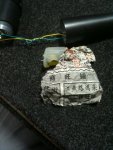Re: Counterfeit Mics
Shure, like many manufacturers, adheres to a Minimum Advertised Price policy. This means that the lowest price an authorized dealer can charge is dictated by corporate policy. For both the Shure SM58 and SM57, that price is $98. If you're buying a brand new 57 or 58 from someone -- be it on eBay or locally -- and their advertised price is far below that price, they're either not an authorized dealer, or you're buying a fake, both bad situations to be in when buying new.
But remember, $98 is the minimum price they can publicly advertise, and sometimes -- especially locally -- the price will work out to less, if they're willing to negotiate at the time of purchase. Still, if the pricing sounds too good to be true, it probably is.
Obviously, used prices will be less, but both SM57 and SM58 prices have remained stable; even in poor aesthetic shape, either of these mics can draw between $50 and $70 for a used microphone.
Look at the XLR connector on the bottom.
On authentic Shure microphones, each of the XLR pins will be labeled as 1, 2, and 3. Most fake microphones will not have these markings, and instead, will have some sort of connector branding logo or, more commonly, no markings at all.
Look under the hood.
On a 58, unscrew the windscreen. Examine the bottom of the windscreen; on the metal ring that goes around the thread, you'll notice a lip. A flat lip is a telltale sign of a fake microphone; the authentic SM58 will have a rounded edge.
Look at the capsule on the top of the microphone. On fake SM58, you'll find a "CAUTION" sticker wrapped around the capsule head. This is not on authentic microphones.
On both the SM58 and SM57, carefully unscrew the microphone in the middle. You'll see the inside of the microphone, with two wires leading between the sections. On the genuine microphones, these are yellow and green colored, and on many fakes, they've followed this color scheme; however, if they're a different color, chances are you're looking at a fake.
Now, look at the circuit board on the lower half. Genuine microphones will have a quality control stamp in red lettering. These will be omitted on the counterfeit mics.
Look & weight of the microphone
On the SM58, underneath the ring where the windscreen connects to the body, there's a printed "Shure SM58" logo. On counterfeit microphones, you'll find that this is a sticker wrapped around the mic itself. A sticker is common on SM57 microphones, but look carefully at the font and the type spacing -- on fakes, it'll be a little wider spacing and a much smaller font.
On both microphones, fake microphones will weigh noticeably less than authentic mics.
Check the box
Microphone counterfeiters have become very good at making Shure packaging look convincing, but one of the sure-fire ways to find out if your mic is fake is to look inside the box.
Authentic mics ship with accessories including a microphone clip, cloth cable tie, Shure sticker, carrying pouch, manual, and warranty card. Fake microphones tend not to include all of these accessories; most obviously missing is the warranty card and cable tie. Also, the bag will be of low quality -- on the original Shure bags (which are indeed made in China), you should be able to feel the embossed Shure logo. Remember, Shure's microphones are made in Mexico, not in China.
Another thing to watch out for: make sure the model number listed on the box matches what's inside. Many counterfeit Shure microphones come with a cable in the box; the only Shure microphone that includes a cable is the Shure SM58-CN. If the box includes a cable but isn't labeled with the proper model number, then you may have a fake mic. Also, some fake SM58 come with a switch attached; the model number should read SM58S. The plain ol' SM58 will be listed as SM58-LC.
Last but not least... trust your ears
Finally, you should take a listen to your microphone up against a known genuine Shure microphone -- finding one to borrow for a project shouldn't be hard, since both the SM58 and SM57 are very common among musicians and engineers.
A fake SM58 will sound very bright and harsh with moderate gain applied. A genuine 58 will sound like, well, a 58 -- smooth in the lows and midrange, with a slightly recessed and pleasant high end. A genuine 57 will give lush midrange tone with great low end response -- a counterfeit will not produce similar results.
Overall, remember the golden rule of buying gear: if the deal sounds too good to be true, it probably is, and you're not getting a fair deal.


